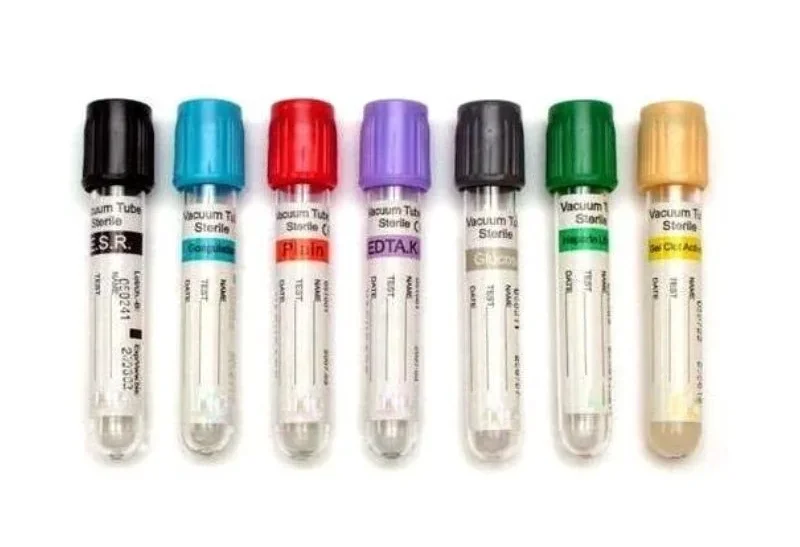
Introduction
- Anticoagulants ek important role play karte hain blood samples ko fluid state mein banaye rakhne ke liye — jisse testing, storage, aur transfusion possible ho.
- Alag-alag tests ya procedures ke liye different anticoagulants use kiye jaate hain.
- Har anticoagulant ka apna specific mode of action, advantages, aur limitations hote hain.
- Neeche commonly used anticoagulants ka detail description diya gaya hai – unke uses, action ka mechanism, faayde aur nuksaanon ke saath:
Ethylenediaminetetraacetic Acid (EDTA)
Uses:
-
Mainly use hota hai hematology tests ke liye jaise CBC, blood smear, aur flow cytometry.
-
Blood cells, especially WBCs aur platelets, ko preserve karne ke liye ideal hai.
-
Blood typing aur cross-matching mein bhi blood banks mein use hota hai.
Mode of Action:
- EDTA calcium ions (Ca²⁺) ko bind karta hai. Calcium clotting ke liye essential hota hai.
- Jab calcium available nahi hota, toh coagulation cascade ruk jaata hai – isse clot nahi banta.
Advantages:
-
Cellular morphology (cells ka shape/structure) ko achhe se preserve karta hai.
-
Platelet clumping ko prevent karta hai, jisse platelet count accurate aata hai.
-
Room temperature pe kaafi time tak stable rehta hai – sample kharab nahi hota.
Disadvantages:
-
Coagulation tests (PT, aPTT) ke liye suitable nahi hai – calcium dependent tests ko interfere karta hai.
-
Agar sample zyada time stored rahe, toh RBCs shrink ho jaate hain – MCV (Mean Corpuscular Volume) galat aa sakta hai.
-
Electrolyte assays mein interfere karta hai – calcium aur potassium levels affect ho jaate hain.
Sodium Citrate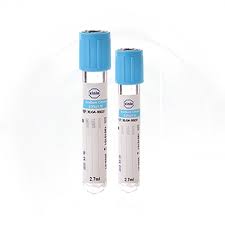
Uses:
-
Commonly use hota hai coagulation studies jaise PT (Prothrombin Time), aPTT ke liye.
-
Blood banks mein plasma preparation aur apheresis mein use hota hai.
-
ESR (Erythrocyte Sedimentation Rate) test ke liye bhi use hota hai.
Mode of Action:
- Sodium citrate bhi calcium ko bind karta hai, lekin reversibly.
- Yani agar calcium dobara add kiya jaye, toh clotting process fir se shuru ho sakta hai – is wajah se yeh coagulation tests ke liye ideal hai.
Advantages:
-
Reversible action hone ki wajah se coagulation studies mein use hota hai.
-
Zyadatar biochemical ya hematological tests mein interference nahi karta.
-
Apheresis aur plasma separation ke time clotting minimize karta hai.
Disadvantages:
-
Blood ko dilute karta hai – agar patient ka hematocrit high ho toh correction factor lagana padta hai.
-
Routine hematology tests ke liye suitable nahi hai – RBCs ka shape/size badal deta hai.
-
Accurate ratio (1:9) maintain karna zaroori hai – galat ratio se test results inaccurate ho sakte hain.
Heparin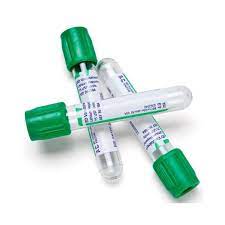
Uses:
-
Use hota hai biochemistry aur clinical chemistry tests mein – jaise blood gas, electrolytes, aur hormone tests.
-
Cytogenetics mein bhi kabhi-kabhi use hota hai jab EDTA ya citrate cell viability ko affect karte hain.
-
Blood banks mein plasma preparation ke liye bhi kabhi use hota hai.
Mode of Action:
- Heparin directly clot formation ko inhibit karta hai by activating antithrombin – jo thrombin aur Factor Xa ko inactivate karta hai.
- EDTA ya citrate jaise yeh calcium ko bind nahi karta.
Advantages:
-
Biochemical analysis, especially electrolytes, mein interfere nahi karta.
-
Jaldi kaam karta hai, urgent tests (blood gas, electrolytes) ke liye ideal hai.
-
Long-term plasma storage mein kuch analytes degrade nahi hote.
Disadvantages:
-
Hematology tests, specially cell counting mein interfere karta hai – WBC clumping ho sakta hai.
-
Coagulation studies ke liye suitable nahi hai – directly clotting ko rokta hai.
-
Agar properly store na kiya jaye, toh fibrin clots ban sakte hain – test results galat ho sakte hain.
Acid Citrate Dextrose (ACD)
Uses:
-
Blood donation, apheresis, aur platelet preparation ke liye use hota hai.
-
Blood preservation for transfusion ya tissue typing mein use hota hai.
-
DNA analysis ya genetic testing ke liye research labs mein use hota hai.
Mode of Action:
-
Citrate calcium ko bind karta hai – clotting ko rokh deta hai.
-
Dextrose cells ko energy deta hai, jisse longer storage ke liye viable bante hain.
Advantages:
-
Cells ki integrity maintain karta hai – long-term blood preservation ke liye ideal.
-
Hemolysis (RBC breakdown) kam karta hai – blood zyada time tak stable rehta hai.
-
Genetic testing aur platelet function studies ke liye suitable hai.
Disadvantages:
-
Blood sample dilute hota hai – kuch tests mein volume adjustment zaroori hai.
-
Routine clinical ya hematological tests ke liye suitable nahi – cell morphology alter hoti hai.
-
Coagulation studies ke liye commonly use nahi hota.
Sodium Fluoride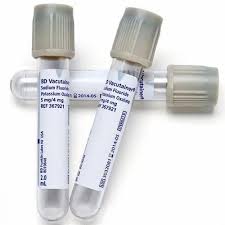
Uses:
-
Glucose testing ke liye sabse important anticoagulant hai – RBCs ke glycolysis ko prevent karta hai.
-
Lactate aur ethanol testing mein bhi use hota hai – metabolites ko preserve karta hai.
Mode of Action:
-
Sodium fluoride glycolysis inhibitor hai – RBCs glucose ko breakdown nahi kar paate.
-
Potassium oxalate calcium ko bind karta hai – clot formation prevent karta hai.
Advantages:
-
Glucose levels ko accurate banaye rakhta hai – long duration ke samples ke liye best hai.
-
Ethanol level preservation ke liye suitable hai – enzymes ko inhibit karta hai.
-
Long storage ke liye stable hota hai – delay hone par bhi sample kharab nahi hota.
Disadvantages:
-
Hematology tests ke liye suitable nahi – cells ka morphology damage karta hai.
-
Kuch enzyme tests ko interfere karta hai – specially glycolysis pathway wale.
-
Potassium oxalate se hemolysis ho sakti hai agar storage proper na ho.
Citrate Phosphate Dextrose (CPD)
Uses:
-
Blood collection bags mein whole blood donation aur transfusion preservation ke liye use hota hai.
-
Jab adenine ke saath combine hota hai (CPDA-1), tab blood ka shelf life aur extend ho jaata hai.
Mode of Action:
-
Citrate calcium ko bind karta hai – clotting prevent hoti hai.
-
Phosphate pH maintain karta hai.
-
Dextrose RBCs ko energy deta hai – storage ke time viable rakhta hai.
Advantages:
-
RBCs ka viability increase karta hai – 21 din tak preserve kar sakta hai (CPDA-1 ke saath 35 din).
-
Hemolysis reduce karta hai – blood transfusion ke liye ideal.
-
Blood banks mein widely used hai.
Disadvantages:
-
Lab testing ke liye suitable nahi – multiple assays mein interfere karta hai.
-
Proper storage zaroori hai – cell viability maintain karne ke liye.
-
Time limit ke baad blood use nahi ho sakta – discard ya process karna padta hai.
Clot Activator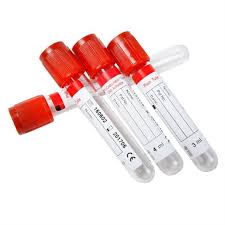
Uses:
-
Used for biochemistry tests (e.g., liver function tests, renal profile, lipid profile)
-
Serology tests (e.g., HIV, Hepatitis, Dengue antibodies)
-
Immunological assays (e.g., hormone levels, thyroid function tests, CRP)
-
Drug level monitoring
-
Collection of serum for storage or transportation
Mode of Action:
-
Is tube mein clot activator hota hai (jaise silica particles), jo blood ko jaldi clot karne mein madad karta hai.
-
Ye particles platelet activation ko trigger karte hain, jisse clot formation fast hota hai.
-
Blood clot hone ke baad sample ko centrifuge karke serum alag kiya jaata hai for testing.
Advantages:
-
Fast clotting: Sample jaldi clot hota hai, isse testing mein delay nahi hota.
-
Serum separation ke liye ideal hai – commonly used for biochemistry, serology, aur immunology tests.
-
No interference with most biochemical assays.
-
Simple storage and handling – no anticoagulant needed.
Disadvantages:
-
Clot ho chuka blood repeat testing ke liye use nahi kiya ja sakta.
-
Not suitable for hematology or coagulation studies – kyunki serum mein clotting factors absent hote hain.
-
Agar mixing ya clotting incomplete ho, toh fibrin strands serum mein reh jaate hain – jo instruments ko block kar sakte hain.
-
Agar turant centrifuge na kiya jaaye, toh hemolysis ho sakti hai.